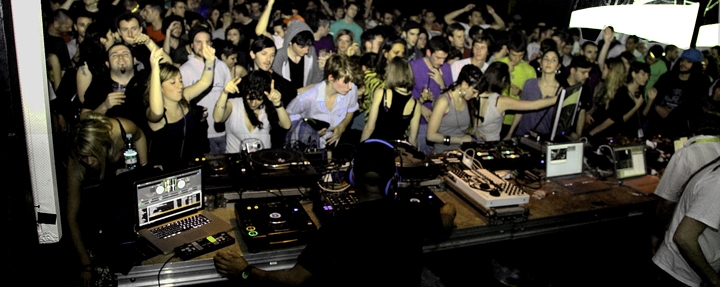Next Step: India To Provide Next Step in Evolution Of Drum & Bass

7 February 2012
I remember when I first heard jungle music. I was ten years old and had wandered into my local high street record store looking to buy any old pop music cassette. They had Prizna - Fire (Feat. Demolition Man - Urban Shakedown Remix) playing over the speakers. I bought it home and loved the fast paced drums, rinsing basslines and “motor-mouth” MCing so much that I had it on repeat for days, driving my mother mad. She couldn't understand it at all, which made me like it even more.
How could I know as a ten year old kid what I was really listening to; what was going on after-hours in raves across the city.
In 1994 jungle was in its heyday; Shy FX, Brockie, and Stevie Hyper D were already household names. New kids on the block Andy C and MC Skibadee were rising fast and helping to create new styles, which were changing the popular sound of what was to be known as drum and bass. Back in my bedroom, I literally played this tape so much so, that it eventually broke. This is where I left the scene. For the time being. Subconsciously I thought jungle was for older kids, and the excitement over jungle was forgotten in the midst of heavy metal and teenage rebellion.
Fast forward to 2002, and my first drum and bass rave, one of the infamous One Nation parties. Even though I was eight years older and had already heard the music before, the experience of hearing that music churn out its lower frequencies on a major soundsystem, with hyper MCs drilling through the flow and the buzz of ravers, made it sound right in its natural environment, and much better because of it. The music was also faster, more influenced by electronic production and less based around reggae and ragga samples. It wasn't even called jungle anymore, it was called drum and bass.
This transition had occurred towards the mid nineties, partly because people in the scene were trying to shake off jungle's bad boy image, and also partly because production processes had become more sophisticated. Moving away from samples of old reggae and funk records, the sounds were synthesised, slicker and futuristic, allowing greater potential for diversity of styles. By the new millennium there existed a new generation of artists such as Bad Company and Pendulum defining the sound and taking drum and bass to new heights of popularity around the world.
This moment in 2002 when drum and bass finally seemed to be emulating if not surpassing the popularity of its predecessor jungle, represents a middle point in the history of the genre, both in terms of the major shift from jungle culture to the sound and culture we know of today, but also in that it occurred roughly somewhere in the mid nineties, about eight years after jungle was born.
Since this time, a more vocal and bigger sounding style of drum and bass has emerged. Producers have come away from their bedroom computers and moved into large studios (either a good or bad thing depending on your preferred sound), but at least drum and bass is moving forward, changing. This is important. Perhaps this less sub-bass focused style has helped drum and bass define the dubstep phenomenon which momentarily threatened its popularity, or maybe it is just a natural evolution which has taken shape around the pioneering work of artists like Pendulum and Subfocus. In any case, drum and bass continues to evolve, an essential part of its survival.
It has surprised us all with its reluctance to die under the wobbles of dubstep's popularity and retreat into the alleys of retrospective “old school nights”. It still needs to continue to move with the times, and what it really needs is a totally fresh perspective on the sound, one that perhaps the UK cannot give it.
That is why I was excited to hear that drum and bass has made its way to India. The first ripples of a burgeoning drum and bass scene have started to emerge in cities across the country with events such as BASSFoundation and Bass Camp. Clubs like Zenzi Mills (now closed) who kick started it down in Mumbai and Zook in New Delhi are being graced by scene leaders emerging to fly the flag for drum and bass in India. Artists such as Vachan Chinnappa, Bay Beat Collective, and BASSFoundation alongside young guns such as Ox7gen are helping to push this sound to the masses.
The rise in popularity has seen drum and bass being included for the first time ever into the music policy of India's biggest festival Sunburn, on the experimental stage, curated by Vachan Chinnapa.
But with such a varying sound and idea of what drum and bass means, between each DJ, event promoter, and producer, as yet there seems to be no consensus on what the Indian drum and bass scene is. That's a good thing. As yet anything goes; and that means that anything is also possible.
I for one am interested to see what develops of the Indian drum and bass scene, as the inevitable rise in popularity continues, and artists influence the next generation of promoters and producers into action.
The Indian drum and bass sound will undoubtedly evolve very fast over the next few years. Make sure that during this time you're locked in to Wild City for the premiere front line connection to the rise of Indian drum and bass as it happens.
*Later this week, drum and bass legends Concord Dawn are heading over to play the 6th edition of BASS CAMP Festival. Details here*
+
Words: Jack Christie